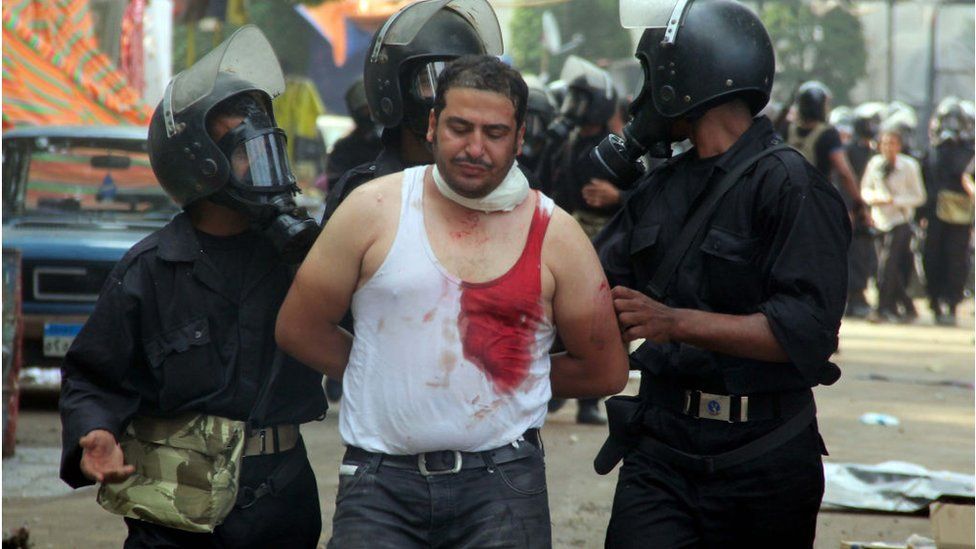Ten years ago, hundreds of people, mostly civilians, were killed when Egyptian forces violently dispersed a sit-in protest by supporters of the recently ousted Islamist president. The crackdown on followers of Mohammed Morsi was one of the bloodiest incidents of its kind, and one of Egypt’s darkest moments. As BBC Arabic’s Sally Nabil reports from Cairo, memories of that day are still raw.
“I wish I was never alive today,” says Amr, who took part in the sit-in that lasted for nearly 50 days, in Rabaa al-Adawiya Square, in the east of the capital.
Amr was only 20 years old when he saw “bulldozers crushing tents, and sweeping whatever came in their way”.
“Humanity was killed in Egypt on that day,” he says.
Amr was arrested a few months after Rabaa, accused of damaging public property and disrupting public order amongst other things. He spent nearly five years in jail, before fleeing Egypt in late 2018 and settling in the UK.
He says he took part in the sit-in because he feared his country would end up in the hands of the army generals.

The violent dispersal of the sit-in at Rabaa and of another one at Nahda Square on the same day were not only unprecedented tragedies in Egypt’s recent history, but were also gamechangers that reshaped the future of the Arab world’s most populous country.
When Mohammed Morsi, a leading figure in the Islamist Muslim Brotherhood group, was elected in 2012, he was the first civilian to make it to the presidential palace, and via a democratic process. It was an extraordinary triumph for his supporters.
One year later though, anti-Morsi protestors took to the streets demanding his resignation. They accused him of following an Islamist agenda and failing to be president for all Egyptians. The army, a dominant political player over the past 70 years, was watching.
Following the protests, the Minister of Defence, Abdul Fattah al-Sisi, removed Mr Morsi from power, bringing an abrupt end to the short-lived civilian rule. Mr Sisi himself was elected president a year later and has held the post ever since.
‘Bodies everywhere’
The Egyptian authorities have always claimed they repeatedly called on the Muslim Brotherhood leaders to end what they called an “illegal” sit-in, but that they were ignored. The state saw Rabaa al-Adawiya square as a rebellious zone that had to be dealt with.
It never occurred to Amr that live ammunition would be used. He thought police forces would resort to much softer tactics like water canon or even tear gas. He said he could not believe how so many lives were lost because of political divisions.
“Dead bodies were everywhere,” he recalls. “We couldn’t keep count. We couldn’t help one another.”
His breathing grows heavy as he gives his account of the day.
“A long queue of civilians, including women and children, were raising up their hands, and leaving the sit-in, when they were shot dead by snipers. I saw them with my own eyes.”
The authorities said they opened safe corridors for people to leave, before they sent in troops. But in a report, published one year after the dispersal, Human Rights Watch (HRW) said security forces “besieged demonstrators for most of the day, attacking from each of the five main entrances to the square and leaving no safe exit until the end of the day.”
Egypt says more than 600 people, mostly civilians, were killed. However, other counts made by the Muslim Brotherhood, now banned in Egypt, speak of more than 1,000. HRW said at least 817 people lost their lives.
The majority of casualties came from the Muslim Brotherhood camp, but some policemen were also killed. Violence continued for days after the dispersal.
‘The living martyr’
The mother of one of those officers still feels the pain of the loss of her son.
Mustafa, says his mother, Wafaa, emerged from the chaos of 14 August unscathed. Two days later, he was shot three times in a gun battle as he was heading to a police station in southern Cairo.

Mustafa was in his 20s when he died in 2016, after being in a coma for three years. During this time, Wafaa never left his bedside in the intensive care unit.
“People who knew him called him the living martyr”, she says.
She controls her tears as she talks to me about her eldest and closest son.
“We’ve been devastated, everything is tasteless without him, we are not alive.”
There is not a single wall in the family’s house that does not have Mustafa’s photo hanging on it. Wafaa tries to find some solace in her eldest grandson, who was named after his late uncle.
Since Mustafa died, his parents have suffered ill health, which they blame on their grief.
When I ask Wafaa about the Muslim Brotherhood’s claim that the protests were peaceful, she is blunt in her response.
“They are a bunch of liars,” she says angrily.
Human Rights Watch said the killing in Rabaa “not only constituted serious violations of international human rights law, but likely amounted to crimes against humanity”.
The Egyptian authorities have denied all these charges vehemently. The Ministry of Interior said participants in the Rabaa sit-in were armed and posed a serious threat to law and order.
“Up till today, when I hear police sirens or a helicopter hovering, I can hardly breathe. I instantly remember,” says Amr, who was arrested a few months after the sit-in and spent about five years in jail.
He says his whole family have been going through trauma since 2013. His younger brother, who has an amputated leg, is still behind bars, accused of belonging to a terrorist group, and his late father was also locked up for a couple of years, accused of protesting without permission.
“Even if I have a chance to return to Egypt, the life I once had is gone,” he says.
Related Topics
- Human rights
- Egypt
